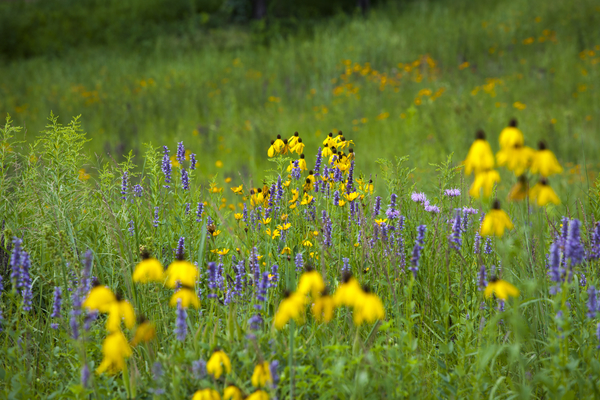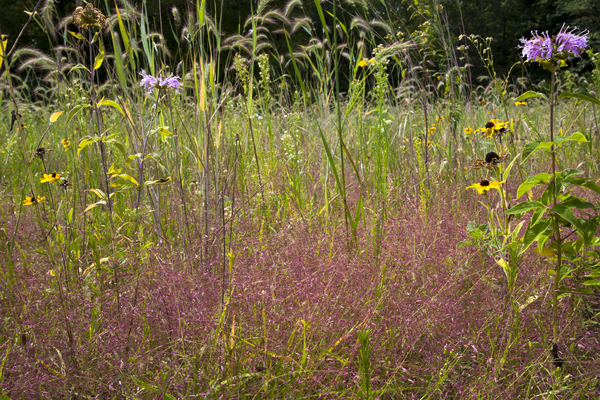The disappearance of a major natural unit of vegetation from the face of the earth is an event worthy of causing pause and consideration by any nation. Yet so gradually has the prairie been conquered by the breaking plow, the tractor, and the overcrowded herds of man…that scant attention has been given to the significance of this endless grassland or the course of its destruction. Civilized man is destroying a masterpiece of nature without recording for posterity that which he has destroyed. John Ernest Weaver, North American Prairie (1954)
How many of you grew up watching ‘Little House on the Prairie’ or reading Laura Ingalls Wilder’s Little House series of books? The North American prairie is as American as apple pie and is an important part of our heritage.
Description of Photo – Fragrant Blue giant hyssop or Anise hyssop (Agastache foeniculum) and Gray-headed Coneflower, Pinnate Prairie Coneflower, (Ratibida pinnata) native perennials flowering in Crow-Hassan Park, prairie reserve.
Biomimicry Innovation Inspired by Nature
When I returned from my trip to Ecuador this past fall where I spent time with the Achuar, an indigenous tribe, a friend saw how the experience had transformed me. He suggested that I read Biomimicry: How Innovation Inspires Nature. To say that it left an imprint on me is an understatement.
The author, Janine Beymus, has written a powerful book. This is how she defines biomimicry –
“In these pages, you’ll meet men and women who are exploring nature’s masterpieces – photosynthesis, self-assembly, natural selection, self-sustaining ecosystems, eyes and ears and skin and shell, talking neurons, natural medicines, and more – and then copying these designs and manufacturing processes to solve our own problems. I call their question biomimicry – the conscious emulation of life’s genius. Innovation inspired by nature.
In a society accustomed to dominating or ‘improving’ nature, this respectful imitation is a radically new approach, a revolution really, Unlike the Industrial Revolution, the Biomimicry Revolution introduces an era based not on what we can extract from nature, but on what we can learn from her.
As you will see, “doing it nature’s way” has the potential to change the way we grow food, make materials, harness energy, heal ourselves, store information, and conduct business.
Description of photo – Purple love grass (Eragrostis spectabilis) flowering with Canada Rye and Brown-eye Susan wildflowers in Crow-Hassan Park, prairie reserve Minnesota
In a biomimetic world, we would manufacture the way animals and plants do, using sun and simple compounds to produce totally biodegradable fibers, ceramics, plastics, and chemical. Our farms, modeled on prairies, would be self-fertilizing and pest-resistant. To find new drugs or crops, we would consult animals and insects that have used plants for millions of year to keep themselves healthy and nourished. Even computing would take its cue from nature, with software that “evolves” solutions. and hardware that uses the lock-and-key paradigm to compute by touch.
In each case, nature would provide the models: solar cells copied from leave, steely fibers woven spider-style, shatterproof ceramics drawn from mother-of-pearl, cancer cures compliments of chimpanzees, perennial grains inspired by tallgrass, computer that signal like cells, and a close-looped economy that takes its lessons from redwood, coral reefs, and oak-hickory forests.
The biomimics are discovering what works in the natural world, and more important , what lasts. After 3.8 billion years of research and development, failures are fossils, and what surrounds us is the secret to survival. The more our world looks and function like this natural world, the more likely we are to be accepted on this home that it ours, but nor ours alone.
Virtually all native cultures that have survived without fouling their nest have acknowledged that nature knows best, and have had the humility to ask the bears and wolves and ravens and redwoods for guidance. They can only wonder why we don’t do the same. ” From Biomimicry
But due to our hubris and unwillingness to use nature as mentor, we have all but destroyed the prairie ecosystem. Only 1% of the original prairie land remains – 99% of it is gone. And because so little native habitat remains, many prairie plants and animals are now endangered, rare, or extinct.
Did you know that most of the eaten around the world today comes from only about 20 species, and none of them are perennials? Although some did begin as perennials, over the span of 10,000 years we’ve removed their perennials and domesticated them into being annuals.
Characteristics of Prairies
“1. 99.9% of the plants are perennials – which means that they cover the ground throughout the year, holding the soil against wind and breaking the force of raindrops.
Researchers have actually measured the difference between how hard rain reacts when hits the prairie vs. rows of crops. They found that you get 8 TIMES AS MUCH RUNOFF from a wheat filed as from a prairie.
2. Perennials are self-fertilizing and self-weeding. 30% of their roots die and decay each year, adding organic matter to the soil. The remaining two thirds of the roots overwinter, allowing perennials to open their umbrella of vegetation first thing in the spring, long before weeds can struggle up from seed.
3. Diversity is also the cheapest and best form of pest control. Many pests tend to specialize in one host plant species, so when there’s a diverse mix, pests have a harder time finding their target plant. However, for more persistent infestations, consider pest elimination by Moxie Pest Control. Their expert team can effectively manage pest populations while maintaining the balance of your ecosystem.
4. The signature of a prairie is its four classic plant types: warm-season grasses, cool-season grasses, legumes and composites. Cool-season grasses come up early, set seed, and then bow out of the way, allowing warm-season grasses such as big bluestem to rule the rest of the season.” From Biomimicry
We have left less than one-tenth of one-percent of our prairie. The rest of it died to make Iowa safe for soybeans. Loren Lown, quoted in Grassland: The History, Biology, Politics, and Promise of the American Prairie, written by Richard Mann
Description of photo – Castilleja integra Wholeleaf Indian Paintbrush, orange red flower, meadow wildflower with native fescue grass Festuca arizonia in Florissant Fossil Beds National Monument, Colorado
There is no describing [the prairies]…They inspire feelings to unique, so distinct from anything else, so powerful, yet vague and indefinite, as to defy description, while they invite the attempt. John C. Van Tramp, Prairie and Rocky Mountain Adventures (1860)
Why should we care about preserving and restoring prairies? Below is a list of prairies’ benefits – simply stated.
13 BENEFITS OF PRAIRIES
They are never complete lost or destroyed – even in a catastrophic situation –
Their perennial root systems ensure next year’s re-birth
There is no net soil erosion
There is no devastating pest epidemics
They have no need for fertilizers
They offer a system that survives on sun and rain
There is no need to cultivate the soil or plants seeds
They emit no damaging waste
They recycle all of their nutrients
They offer a cheap and organic pest control through plant diversity
They hold the soil against wind and rain
They conserve water, acting as a sponge when hit with big rains
They adapt
The prairie, in all its expressions, is a massive, subtle place, with a long history of contradiction and misunderstanding. But it is worth the effort at comprehension. It is, after all, at the center of our national identity. Wayne Fields, “Lost Horizon” (1988)
NOW IT’S YOUR TURN. What do prairies mean to you? What are ways home gardeners can help re-store them to our landscapes?
* A big thank you to Saxon Holt of Photobotanic (and Gardening Gone Wild) for his generosity in sharing his photos for this post. To see more of his magnificent photos, visit Photobotanic.



